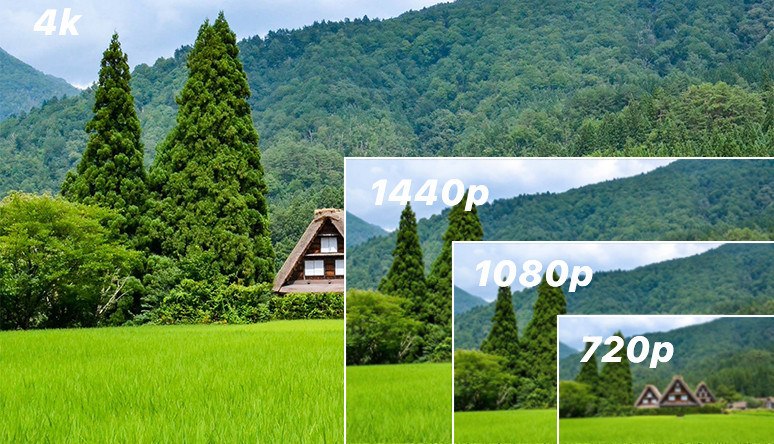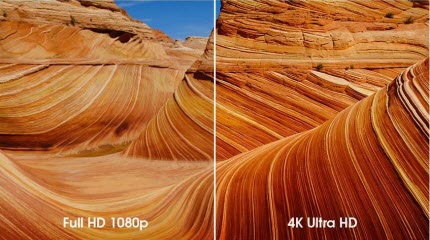With the constant advancement of technology, average people are becoming more concerned about the specifications of their devices. While this isn’t a negative trend, it has resulted in some misconceptions which may encourage people to spend more money than necessary. When it comes to video quality, people always seem to talk about 4k and HD. Ever since 4k became available to the average consumer, it has become all the rage. Many people won’t even consider purchasing an HD projector when there are 4k options.
The popularity of this term has kept many people from understanding the differences between 4k and HD projectors. When people hear the word ‘4k’, there’s instant amazement and excitement associated with any product. Everyone seems to have an inclination to believe that any 4k projector is the better choice when compared to HD options. In this article, we’ll take a look at the differences between 4k and HD projectors and decide whether or not these discrepancies are worth the price differences.
Technical Differences Between 4k and HD Projectors
In short, image quality and resolution is the primary technical difference between 4k and HD projectors. Although 4k is the most popular name for this form of image quality, it is also referred to as Ultra High Definition or UHD. 1080p has always been labeled as High Definition. The numbers in each name refer to the image resolution of each type. 4K UHD projectors process videos with a resolution that is 3840 x 2160 pixels. This is rounded up to 4,000 in order to simplify the name. On the other hand, 1080p HD videos have a resolution consisting of 1920 x 1080 pixels.
Traditionally, the vertical measure of pixels gave a resolution its name. However, 4k is a reference to the horizontal pixels of this image quality. When referring to 1080p, people are talking about the resolution’s exact number of vertical pixels. 4K features more than twice the number of vertical pixels as 1080p. Technically speaking, this is a steep increase. 4K projectors contain nearly four times as many pixels as 1080p models. With a 16:9 aspect ratio, 4k projectors can display over 8 million pixels. In contrast, 1080p projectors can display around 2 million pixels.
Do these technical differences make a difference in everyday life?
While it’s important and helpful to know the specific differences between 4k and 1080p projectors, this technical information isn’t really applicable to everyday life. It’s much more practical to understand how these specs translate into the quality of a projector’s display.
In reality, the average viewer won’t be able to tell the difference between a 4k and 1080p projector. This is especially true when a projector is displaying an image on a screen or backdrop that isn’t perfectly clear or white. Even when watching a video on a clear computer screen, the difference between 4k and 1080p quality isn’t immediately noticeable to the average person.
If you have trouble reconciling this reality with the clear technical differences between each image resolution, you can run a simple test by yourself. Pull up two tabs in your computer which display the same YouTube video. Place one of the videos in 4k quality and the other in 1080p. If you try to spot any noticeable differences, you’ll quickly realize that it is nearly impossible.
If these differences in image resolution cannot be differentiated on a computer screen that is only one foot from your face, it stands to reason that projectors with 4k and 1080p quality would be even more difficult to tell apart. Despite the inherent technical differences between UHD and HD projectors, there isn’t a practical difference that matters enough to justify the cost of 4k models.
Are HD projectors affordable?
Now that you understand the practical differences between 4k and HD projectors, you may have reconsidered spending thousands of dollars on a UHD model. However, there are some people who still may struggle to justify the purchase of an HD projector. It’s not uncommon to find new models for over a thousand dollars.
While a lot of people are still under the impression that you can only achieve HD quality image with a $1000+ projector, that definitely isn’t the case now. The quality of a projector that cost $1,000+ last year can now be achieved with one under the 200 dollar range. Producers have released enough HD models to drown out the competition.
The same cannot be said for 4k projectors which are still somewhat of a novelty. In addition to the enhanced image resolution, people are also paying a lot of extra money to have the name ‘4K’ in the device. There’s a tendency that consumers have to imbue certain words or technical terms with inherent value. This trend is usually reflected in incredibly high prices.
For those people interested in buying HD projectors, this tendency actually makes models that don’t fall into the 4k category much cheaper. People are coming in droves to sell their old HD models in order to own that highly sought after 4k projector. This leaves the informed consumer with excellent choices within the HD category that produce indistinguishable results at a fraction of the overall cost.
Although there are some technical differences between 4k and HD projectors, there is no reason to spend thousands of dollars more for one model. There are several new and used HD projectors which will provide enough resolution to offer any user a high-quality viewing experience. Whether you’re using a projector for gaming or watching movies, you’ll find that HD projectors offer more than enough resolution. Furthermore, you’ll be able to invest in other equipment with the money saved from avoiding the steep cost of 4k projectors.





